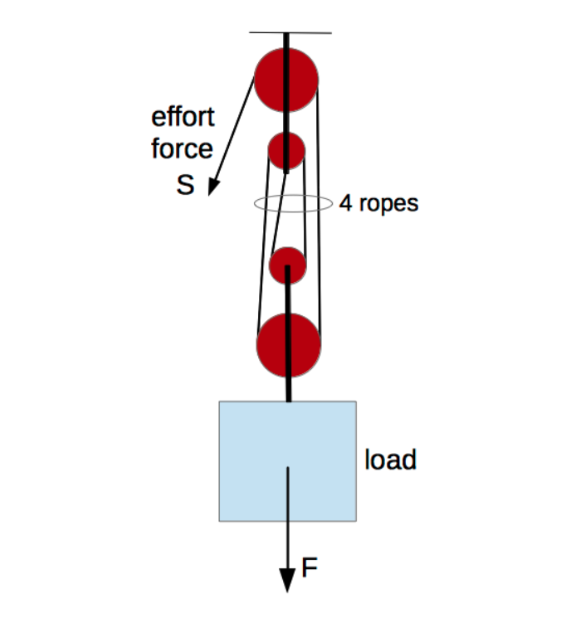 Home
Home
 Back
Back

Definition: This calculator computes the effort force (\( S \)) required to raise or pull a load using a block and tackle system, based on the mass (\( m \)), gravitational constant (\( g \)), mechanical efficiency (\( \mu \)), and number of ropes (\( n \)).
Purpose: It is used in mechanical engineering and physics to determine the force needed to lift a load with a pulley system, accounting for mechanical advantage and efficiency losses.
The calculator uses the relationship:
Where:
Explanation: Enter the mass, mechanical efficiency, number of ropes, and gravitational constant in the chosen units. The mass is converted to kilograms, and the gravitational constant is converted to m/s². The effort force is calculated as \( S = \frac{m \cdot g}{\mu \cdot n} \), where the result is the force in Newtons. Results are displayed with 5 decimal places, using scientific notation if the value exceeds 100,000 or is less than 0.0001. For default inputs (\( m = 100 \, \text{kg} \), \( \mu = 1 \), \( n = 1 \), \( g = 9.81 \, \text{m/s}^2 \)), the calculated effort force \( S \) is approximately 981.00000 N.
Details: Calculating the effort force for a block and tackle system is essential for designing lifting mechanisms, optimizing mechanical advantage, and accounting for efficiency losses in real-world applications such as cranes and hoists.
How do I calculate the effort force for a block and tackle system?
Measure the mass (\( m \)), mechanical efficiency (\( \mu \)), number of ropes (\( n \)), and gravitational constant (\( g \)). Compute the effort force using the formula \( S = \frac{m \cdot g}{\mu \cdot n} \). The result will be in Newtons (N).
What does the effort force represent?
The effort force (\( S \)) represents the force required to lift a load, adjusted by the mass, gravitational constant, mechanical efficiency, and number of ropes in a block and tackle system.
What is the formula for the effort force in a block and tackle?
The formula for the effort force is \( S = \frac{m \cdot g}{\mu \cdot n} \), where \( m \) is the mass, \( g \) is the gravitational constant, \( \mu \) is the mechanical efficiency, and \( n \) is the number of ropes. The standard unit for force in this calculator is Newtons (N).
Can I use different units for mass and other parameters?
Yes, the calculator supports multiple units for mass (g, kg, lb, oz, tons, US gallons, UK gallons), gravitational constant (m/s², ft/s²), and efficiency (as a fraction). All inputs are converted to kilograms and m/s² for the calculation.
What happens if I enter zero for the number of ropes or efficiency?
Entering zero for the number of ropes (\( n \)) or efficiency (\( \mu \)) will result in the calculation not being performed, as the formula involves division by these values. Both must be greater than zero (efficiency ≤ 1) for a valid result.